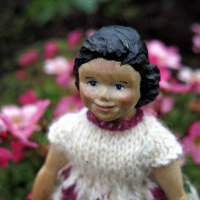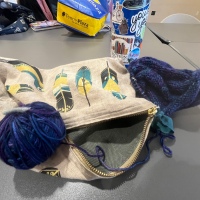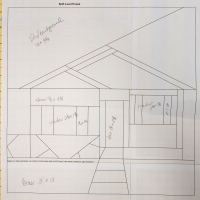We Interrupt Spring Cleaning…
As I have mentioned before, after our daughters grew up and moved out, my husband and I downsized from our typical suburban home, into a cottage that his family had built on their farm. The cottage was already full of furniture and other useful items that his family members had left here. My ongoing project is to reduce our total number of possessions, but it is really hard, because we keep coming across more really cool stuff.
This weekend, I planned to do some spring cleaning, but my thoughtful husband forwarded me an email from a local auction house – they were having an estate sale, and it featured “antique linens.”
Usually this term is used very loosely, to mean “we have three stained polyester tablecloths and a Care Bears bedspread,” but I thought I should go look, just to be nice.
It turned out that the deceased’s mother had been an antique dealer, and there were about 25 boxes of actual, vintage linens! Most of the items had been prepared for sale, so they were cleaned, folded, and tagged with their measurements. There were only about two other interested buyers, so I ended up with 6 good size boxes full.
I have spent today cataloging my finds, and I ended up with over 300 items, at a cost of 14 cents each! Here are a few of my favorites:

This dresser scarf has very heavy crocheted trim on a fabric that is almost as light as cheese cloth. That caused the fabric to tear, but the trim is the real treasure.
It’s a little sad to see someone’s possessions just thrown into boxes willy-nilly and hauled out for everyone to see. But I think this antique dealer would be happy to know her treasures went to someone who appreciates them, and in the event my textiles end up the same way, I would be glad to pass them on to another textile lover.
There weren’t any real show stoppers in the boxes, but I did get a lot of beautiful cotton and linen items in useable condition. There were a few where the fabric is beyond saving, but the trims are worth keeping. And the ones that are just “run-of-the-mill,” I will use in other creations.
I have been to the standard auctions where you sit in a chair and hold up your number to bid. This auction was much more informal, so I thought I’d explain how it runs in case you are interested in auctions and find yourself at a similar one.
Before bidding you go to the counter to get your bid number. You can’t bid without one, and you might think, “Good, that will keep me from spending money,” but it will also keep you from snapping up a bargain!
All the items are set up in rows. You walk around and look at everything to decide what you want. (I make a mental note of how much I am willing to spend for an item.)
The auctioneer walks to each item and everybody trails along (making it very hard to see). If it is a big item, like a refrigerator, he auctions that off by itself.
Small items are grouped together – there could be ten paintings together, or ten silk plants, or twenty little bags of costume jewelry. The bidding starts, and when it stalls out and the auctioneer knows he is not going to get any more money for that item, he gives the highest bidder her choice. If she won with a $20 bid, she can take as many of the items as she wants from that category at that per item price. Let’s say she takes two paintings out of a group of ten – the auctioneer will then let the second place bidder get as many as he wants, at whatever his last bid was, say $15. If that bidder also takes two, there are six left, and the bidding starts over. (The highest and second bidder can rejoin at a low bid at that point. They are not tied to their earlier bids.)
if you bid on a couple of things in a category, the auctioneer starts to remember you and give you a chance to get a bid in.
As the price drops lower, the auctioneer might offer anyone the chance to choose a bag or box for a certain amount – then you just kind of grab, and tell the auctioneer’s notetaker your number and how many you got. Finally, he might lump the remainder of items all together to get rid of them. This is how I ended up with so many linens – I got the box I wanted for $12.50, and then as the bidding came down to “take any box for $5,” I just had to help them out.
Your items are marked with your number on a piece of masking tape and placed on a table. Little tickets with your winning bids are run to the office. At any time, you can go pay for what you have purchased, and then load your treasures to go home.
And then try to find a spot for them in your house…




















How lucky, I love old linens. Stained linen especially damask is beautiful when dyed with indigo.
That is good to know! There were about 20 tablecloths in the lot, most of them mass-produced damask. Four of them are pink! So I may try indigo on them. One can only have so many pink tablecloths. 🙂
Everything you describe here is my idea of heaven! Auctions, old linens–I’m envious! A cautionary note, though–buying big lots of old linens is what got me into the business of selling vintage linens on Etsy. Once I bought them, I felt responsible for finding them good homes . . .
It did cross my mind! But then I think I would constantly go to more auctions, and I would be regretful for the bargains I missed (like at this auction, there were phenomenal old beaded bags that went for $15 – I didn’t get any because I just can’t start one more area of interest!), and then I would build up an inventory with no place to store it properly…
I will check you out on Etsy, though!
You just described my world. It all started so innocently, selling some of my hoard. but, then, I bought more . . . and more. Well, you know, the prices were so low and those poor linens were homeless . . .
So glad you decided to visit the auction as you purchased some beautiful linens. I too have all of my mother’s linens and several of my grandmother’s. Interesting way the auction was conducted. I’m like you though as my space is limited so while I’d love to buy some new pieces, I tend to shy away from picking up more!
Isn’t it sad- when we were young and starting out with an empty house, we had no money, and now that I have enough money to spend on bargains, I have no room!
I will make sure all of these find a good home though – the real fun was in going through them all.
Oh my!!! You scored big time!!!! Many awesome creations in your future!!!!!! Yay!!!!!
I’m getting so many new ideas just from the comments!
Yes, that certainly can happen…..we’re here for ya!!!! Hugs…………………
As others have commented, I love reading of the treasures you found… I, also, have a passion for old linen, particularly damask, which I have in so many colours and also pillow shams and the very fine linen tray cloths.. The largest of the tray cloths make great pillow shams… If only I had another house to store all I would love to collect. I do make embroidered evening bags out of many of my treasures though and they are welcome as gifts… Irresistible lace trimmings make great bookmarks, backed by scraps of linen or ribbons…they are also good for glasses cases…
So long as they are enjoyed and not discarded, I’m happy to give them a new lease of life.
Yes, I too mentioned to my husband that I need another whole house, just to decorate and enjoy. We would have to just visit it a few moments at a time so it would stay clean and tidy, but it would be so refreshing to visit!
Thanks for the ideas and it will be fun to match them to the items!
😀 That is very cool. I happened into an antique shop on Friday and found buried among some old quilts a bag of yards of muslin and old flour sack cloth for just a couple bucks. Yards and yards of it. Since I’d just been wishing that I had some inexpensive fabric to try my hand at eco-printing, I took it as a sign from the Cosmos. I know what you mean about seeing someones treasured things tossed into a box. I feel that way every time I go into a junk shop and see old sepia or black and white family portraits. Those were someone’s loved ones, you know? And now they’re in some dusty shop hoping to fetch a buck. Can you imagine our old family photos in a thrift store 100 years from now? I can’t, and I bet those people would never have thought their Great Aunt Eula’s photo would be sold like that either. Or the table cloth she embroidered. Or the lace she tatted. I can’t help but wonder what stories are woven in all of those things.
Your find sounds wonderful too! I love the odds and ends of supplies better than the finished masterpieces – it’s like you’re in partnership with the original artist rather than being just an admiring audience member.
Pingback: Say It With Linens | Deep in the Heart of Textiles
Pingback: Flour Sacks – and More! – Quilt | Deep in the Heart of Textiles